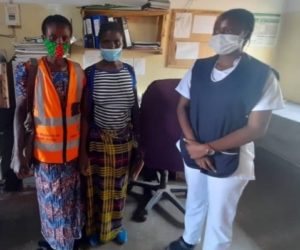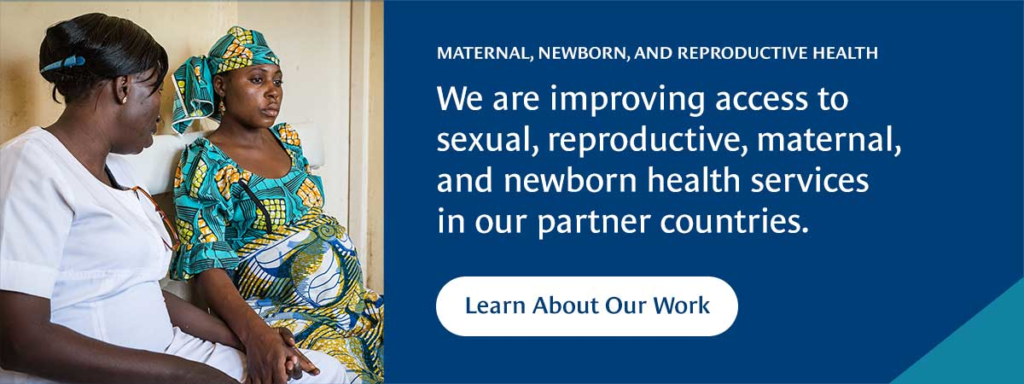She was in labor and a 12 mile walk to the nearest health facility when complications began. On the International Day of Rural Women, we look at the barriers rural women face in accessing urgent maternal, newborn, and reproductive health services – and how CHAI is responding in Zambia.
When Beauty Chileshe went into labor in the early hours of the morning, she and her husband decided to wait until the sun came up to head to the township clinic – it was an over 12-mile journey from their small, rural village and walking that distance at night was accompanied by potential dangers due to poor visibility: from rough road to animals and snakes.
The next morning, Beauty’s husband balanced her on his bicycle and began the trip. Soon, Beauty told her husband they needed to stop, she was bleeding. She was halfway to the clinic and had begun to hemorrhage.
Obstetric hemorrhage is one of the leading causes of maternal mortality in Zambia. It accounts for 34 percent of all maternal deaths nationwide. Women who live in rural areas, like Beauty, are more likely to die from hemorrhage and other preventable causes like sepsis, obstructed labor, and eclampsia at home or on the way to health facilities. This is partly due to the long distances they must travel, often on uneven roads, while in labor – on average nine miles, compared to three miles for women in urban areas.
Women who live in rural areas are more likely to die from hemorrhage and other preventable causes at home or on the way to health facilities.
There are other challenges too. Inequities exist in the distribution of sexual, reproductive, maternal, and newborn health services between urban and rural areas, with rural communities facing too few trained health providers, inadequate infrastructure and equipment to support delivery, poor communication between facilities, and limited family planning commodities, all further undermined by an unreliable supply chain.
Luckily, for Beauty, her husband managed to get her to the township clinic after she passed out.
“I cannot remember what happened after that, only to find myself in the clinic ward wrapped in some material. I did not know what it was. The nurse said…it is what made you to survive,” said Beauty.
The material was a non-pneumatic anti-shock garment (NASG). The garment is a stretchy wrap that stabilizes a woman in shock from postpartum hemorrhage by applying pressure to her lower body and abdomen. The NASG gives time to seek treatment – in Beauty’s case, for her nurse to arrange transportation to the Mporokoso district hospital, where staff were able to control her bleeding and save her life.
Far too many women living across rural Zambia are not able to get to the clinic in time when they start to develop complications. Those who are able to make the often-arduous journey in time will often arrive to find the health facility understaffed, essential equipment they need unavailable or emergency transportation to the hospital unreliable or nonexistent. These women are unlikely to survive complications experienced during pregnancy.
Strengthening and extending services to hard-to-reach areas is central to CHAI’s approach
CHAI has developed an integrated maternal, newborn, and reproductive health strategy to dramatically reduce unintended pregnancies, maternal and neonatal deaths, and stillbirths, particularly for women and girls in rural areas. Our approach begins with educating teenagers about reproductive health services and continuing to support women through their reproductive years. We also work with health providers to identify complications early, apply interventions immediately, and quickly refer cases to the appropriate level of care for treatment. We have been implementing this approach in Zambia’s Northern Province, one of the most rural regions in the country, since 2018.
Key to realizing these goals is a strong community health system, which can increase maternal, newborn, and reproductive services in hard-to-reach areas. In Zambia, the community health system is comprised of first responders, such as neighborhood health and village committees, traditional leaders, and volunteers. These mostly women-led groups are responsible for educating their communities about the health services available to them, creating demand for those services, and responding to emergencies.

SMAGs refer and escort women to the nearest facility for family planning.
CHAI works to ensure first responders are incorporated into the wider health system and are equipped with the skills, tools, and supplies they need to identify risks, stabilize patients, and refer them to appropriate levels of care. Over the last four years, we have worked with the Ministry of Health to identify, train and equip many groups: traditional leaders, community health assistants, Safe Motherhood Groups (SMAGs), community-based distributors (CBDs).
When working together, these groups can effectively support women and girls’ reproductive and pregnancy needs by supporting formation of a Network of Care that links and deliberately coordinates service delivery from the most rural of communities through each level of the health system up to the hospital. Traditional leaders create demand for services; community health assistants educate women and girls; SMAGs track women from pregnancy to postnatal care and provide family planning counselling; and CBDs provide short-term family planning services and refer women who are interested for long-acting reversible contraceptives. Community motorbike riders transport girls, women, and newborns to the nearest health facility during emergencies.
Women leading the way to improve maternal, newborn, and reproductive health in rural Zambia
Representing wider improvements to the health system, two nurses helped ensure Beauty’s experience was different from that of so many other women living in rural areas and suffering similar conditions. Marjory Tembo applied the NASG to Beauty at the township clinic and arranged for emergency transportation to the hospital, and Natasha Chirwa quickly mobilized the theatre team to perform a caesarian section when Beauty arrived.
Natasha received Emergency Obstetric Neonatal care (EmONC) training through CHAI. Since then, Natasha has been providing Marjory with EmONC mentoring. Due to this, they were able to diagnose Beauty quickly and apply the necessary interventions to save her life.
“Since [we received training], healthcare workers demonstrate improved skills to identify danger signs and make correct decisions,” said Natasha. “Though the outcome for the baby was not good, Beauty survived. Before…women with maternal complications were more at risk of dying, but not [we] are able to save their lives.”






